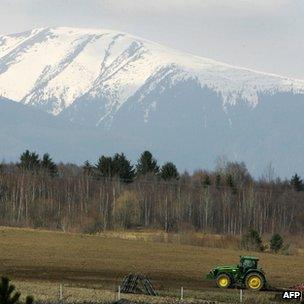EU brings farms and forests into low-carbon plans
- Published

Ploughing releases CO2 from the soil - but plants also soak up carbon
The EU has called on European governments to include data on CO2 emissions from farming and forestry in their efforts to tackle climate change.
The draft law on accounting rules is in line with what was agreed at the Durban climate change conference in December.
But the EU does not yet plan to include farming and forestry in its CO2Emissions Trading Scheme (ETS), external.
The goal is to accurately measure CO2 emissions from biomass used for energy and from ploughing and logging.
The European Commission - the EU's executive arm - says the current rules covering agriculture and forestry account for two of the three main greenhouse gases - methane and nitrous oxide - but not CO2 (carbon dioxide).
Growing plants absorb large amounts of carbon through photosynthesis, but ploughing releases CO2 from the soil. Decaying plants also release CO2.
"What we propose today is harmonised rules to account for forests and agriculture emissions. This is the first step to incorporate these sectors into the EU's reduction efforts," said the EU Commissioner for Climate Action, Connie Hedegaard.
"In Durban all countries agreed revised accounting rules for these sectors. The EU is now delivering with this proposal.
"The proposal will also contribute to protect biodiversity and water resources, support rural development and have a more climate-friendly agriculture."
The new rules, externalnow go to the environment ministers and European Parliament for discussion, and it is not yet clear when they will take effect.
Dispute over CO2 target
Earlier Ms Hedegaard voiced regret that Poland had blocked a more ambitious EU target for CO2 emissions cuts.
Poland said no to the Commission'slow-carbon roadmap, externalat a meeting of EU environment ministers on Friday.
Denmark, currently steering EU negotiations, was backed by the UK in calling for a 25% cut in CO2 emissions by 2020. Previously the target was 20%.
But Poland, reliant on coal for more than 90% of its electric power, fears the move would make energy more costly.
Ms Hedegaard said Poland's veto was "unfortunate, but it will not stop Europe from moving on with its transition to a low-carbon economy".
"The bad news was that Poland blocked [EU] Council conclusions for the second time. The good and encouraging news is that Poland was the only country to block.
"The presidency and the other 26 member states explicitly asked the Commission to move on, and that is what we will do," she said.
The Commission says the most cost-efficient way of moving to a low-carbon economy is by achieving a 40% cut in CO2 emissions by 2030 and a 25% cut by 2020, compared with 1990 emission levels.
The overall target is an 80% cut by 2050, based on the "greening" of industry, investment in energy-efficient electric cars and housing, renewable energy and modernised, "smart" electricity grids.
Currently the ETS only covers energy-intensive industries such as power generation and cement-making.
The EU's introduction of carbon charges for aviation in January is highly controversial - it has angered airlines and global rivals such as the US and China.
The EU also plans to include shipping in measures to curb CO2 emissions.
- Published12 March 2012
- Published23 February 2012
- Published8 February 2012